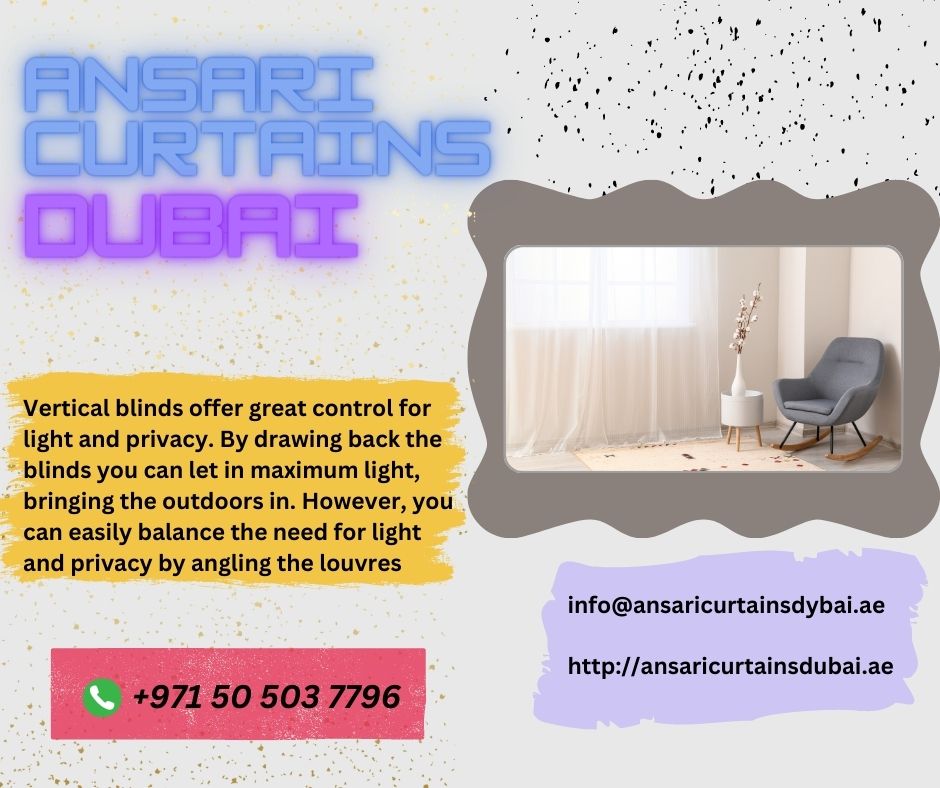Vertical Blinds:
Vertical blinds are relatively easy to maintain. Regular cleaning with a damp cloth or vacuuming can help remove dust and debris. For more extensive cleaning, some materials may require professional cleaning or the replacement of damaged slats.
Introduction:
Vertical blinds are a popular window treatment option that can be found in many homes and offices. They consist of vertical slats that can be adjusted to control the amount of light that enters a room, as well as to maintain privacy. Vertical curtains are a practical and versatile solution that can be used in a variety of settings. In this article, we will take a closer look at vertical blinds and explore their features, benefits, and drawbacks.

What are vertical blinds?
Vertical curtains are window treatments that consist of vertical slats or louvers that hang from a track. The slats can be made from various materials, including fabric, vinyl, aluminum, and wood. The slats can be adjusted to control the amount of light and privacy, and they can be opened fully to allow maximum light and views.
Features of vertical blinds:
Vertical curtains come in a range of materials, colors, and sizes to suit different preferences and settings
.
Here are some of the features of vertical blinds:
Material:
Vertical blinds can be made from fabric, vinyl, aluminum, or wood. Each material has its unique look and feels, as well as pros and cons in terms of durability, maintenance, and insulation.
Slat size:
Vertical curtains come in various slat sizes, from narrow to wide. The slat size can affect the amount of light that enters a room, as well as the overall aesthetic.
Track type:
Vertical curtains can be mounted on different types of tracks, such as a wand control, cord control, or motorized control. The track type can affect the ease of use and the safety of the blinds.
Benefits of vertical blinds:
Vertical blinds offer several benefits that make them a popular choice for many homes and offices.
Here are some of the benefits of vertical blinds:
Light control:
Vertical curtains allow precise control over the amount of light that enters a room. The slats can be adjusted to block or filter out light, or to let in maximum light.
Privacy control:
Vertical curtains also offer excellent privacy control. The slats can be adjusted to block or expose the outside view, and they can be opened or closed as needed.
Energy efficiency:
Vertical curtains can help to improve energy efficiency by reducing the amount of heat or cold that enters a room through the windows. They can also help to reduce glare and UV damage.
Versatility:
Vertical curtains are versatile and can be used in a range of settings, from bedrooms and living rooms to offices and conference rooms. They can also be customized to fit unusual window shapes and sizes.
Easy maintenance:
Vertical curtains are relatively easy to maintain, as they can be wiped down with a damp cloth or vacuumed to remove dust and debris. Some materials may require more extensive cleaning or replacement over time.
Drawbacks of vertical blinds:
While vertical curtains offer several benefits, they also have some drawbacks that should be considered before making a purchase.

Here are some of the drawbacks of vertical blinds:
Limited insulation:
Vertical curtains do not offer the same level of insulation as some other window treatments, such as drapes or cellular shades. They may not be ideal for extremely hot or cold climates.
Noise and rattling:
Vertical curtains can be noisy when they move, especially if they are made from metal or plastic. The slats may also rattle in the wind or when there is a draft.
Maintenance:
While vertical curtains are relatively easy to maintain, they may require more upkeep than some other window treatments. The slats may need to be replaced over time, especially if they become damaged or discolored.
Limited aesthetics:
While curtains come in a range of materials and colors, some people may find them less attractive than other window treatments. They may not be suitable for all decor styles or personal preferences. INNOVATIVE SUN
FAQS:
What is the best material for vertical blinds?
The best material for vertical curtains depends on your needs and preferences. Vinyl is a popular choice for its durability, ease of maintenance, and affordability. Fabric vertical blinds offer a softer look and more color options but may require more maintenance. Aluminum and wood vertical curtains are also options but tend to be more expensive
.Can vertical blinds be customized to fit unusual window sizes?
vertical curtains can be customized to fit unusual window sizes and shapes. Some manufacturers offer made-to-measure options or can cut the slats to fit your specific needs. It’s important to measure your windows accurately and consult with a professional installer to ensure a proper fit.
Are vertical blinds energy-efficient?
Vertical curtains can help improve energy efficiency by reducing the amount of heat or cold that enters a room through the windows. However, they may not be as effective as some other window treatments, such as cellular shades or drapes, which offer better insulation.
Can vertical blinds be motorized?
vertical curtains can be motorized for added convenience and ease of use. Motorized vertical blinds can be controlled by a remote or a wall switch, and can be programmed to open and close at specific times. However, motorized options tend to be more expensive than manual controls.



